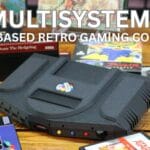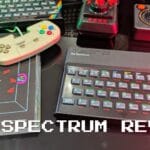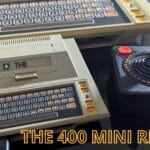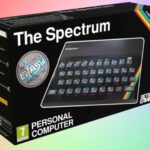Table of Contents
In this Retro Restore video I take a look at the Welsh made Dragon 32 home computer. The Dragon 32 and Dragon 64 are home computers built in the 1980s. The computers are similar to the TRS-80 Color Computer (CoCo) and were made for the European area by Dragon Data Ltd in Swansea. The two models difference is the amount of memory, 32k and 64k in their respective models. The Dragon is built around the Motorola MC6809E processor running at just 0.89 MHz! It used an advanced 8-bit CPU design, with some limited 16-bit capabilities. With busted and leaking capacitors, corroded boards and more… does the Dragon breathe fire again?
Dragon 32 Retro Restore Video
Parts used in the video
- RCA AV Cable – https://www.retrocomputershack.com/
- Dragon 32 Replacement sticker – https://www.ebay.co.uk/itm/Dragon-32-Replacement-Sticker/284070967422
- (Below Contains affiliate links)
- Contact Cleaner – https://amzn.to/3jIbWoK
- Isopropyl Alcohol – https://amzn.to/376iBUB
- ESD Brushes Kit – https://amzn.to/3aX3YEc
- Compu Cleaner Air Duster – https://amzn.to/3qcu5xg
- Jerome Russell Bblonde 40 Vol 12% Peroxide Cream 5ml – https://amzn.to/373P8dS
- Onforu UV Strip Light – https://amzn.to/3jEGYxs
Dragon 32 Retro Restore (Text)
I picked up this sorry looking Dragon 32 last year and as always before powering on, I open computers and consoles to check for any damage such as leaking capacitors. I already had warning signs, as the smell test gave me that dreaded smoky leaked capacitor smell which was not a good sign.
There’s four screws holding the case in place. The security seals were unbroken and I had popped the stickers beforehand, so the internals had not been tampered with.
Flipping it back over, the top half of the case comes neatly off giving us access to inside.
Immediately I can see this is always why you should check before powering on. You can see that the power supply board has got some issues. The capacitors have leaked and there’s a fair amount of corrosion on the board, screws and the case.
The main motherboard however does not look to be in too bad condition.
So let’s get everything taken apart for a closer look.
I start with unscrewing the power supply board. The screw on the top right is very corroded and full of rust. I tried unscrewing it but it wouldn’t hold. I didn’t want to risk damaging anything so I put some contact cleaner on the screw and let it work in for a bit before cleaning it up with a cotton bud to remove the rust.
This allowed me to get a good hold with a screwdriver and thankfully the screw was free.
With that, the power supply cable can be disconnected, and then the power board can be removed.
There’s a lot of corrosion on the back of the board but it doesn’t look very damaged. I will definitely need to replace the capacitors. One was so bad the leg was broken off the board.
First I want to clean some of the corrosion off to confirm if there is any actual damage to the traces. So using some contact cleaner I spray it over the affected areas and clean it off with some cotton buds.
It looks mainly like the corrosion is superficial and has not damaged the board which is great news. So I finish off cleaning the board, ready to desolder the capacitors.
I am not an expert solderer, so yeah feel free to complain in the comments 🙂 Using some desoldering braid and a soldering iron, I suck up all the old solder and the capacitor wires are pretty much falling out. Using the braid I remove any excess solder left for each solder point.
Once they have been removed, I spray some isopropyl alcohol and give everything a clean ready to solder the new capacitors which I have ordered.
Thanks to the lockdown in the UK back in late November the capacitors took a bleedin age to arrive via Royal Mail. But they got here eventually.
Making sure the capacitor wires are in the correct way I get started on the soldering. It is pretty straight forward, thankfully no surface mounted ones to solder!
I didn’t have a chance to record it, but off camera I connected just the power board to the power supply and tested it with a multimeter. It was giving a 12 and 5 volt power on the correct pins, so everything appears to be working OK now. We will have to wait for the full test to see if there’s any other issues.
Now that is done I can move on to the keyboard and main board. The keyboard is held in with two screws. The keys are fairly clean looking so I don’t think they will need retrobrighting, just a clean in some soapy water.
The keyboard ribbon looked quite fragile to remove so I decided to leave it connected and remove the keyboard and main board together. There’s a few screws holding the motherboard in place.
The case is looking very dirty but thankfully nothing seems to be cracked or broken. I will get the case prepared for a little retrobrighting as the lower half of the case is a bit darker than the top.
I start off with some IPA and go over the board removing any stuck in dirt and grime. The Dragon 32 label is starting to peel off so I was in two minds to keep it or not. Going around all of the case, I scrub it with a toothbrush and rinse it off.
There are some minor scuff marks and dirt which wouldn’t come out, so using some Bicarbonate of Soda and water, I apply it to these areas and work it in with the toothbrush. It works as a gentle abrasive and removes the dirt from the areas.
The Dragon 32 sticker was peeling off so I decided to remove it and order a replica replacement for it which I will add later. At least now I can give this area a good cleaning without worrying about damaging the sticker.
Next I start work on cleaning the bottom of the case. Again cleaning it with IPA and brushing a few scuffs with bicarbonate. Then it is all rinsed off and ready to retrobright with the top half of the case. I have shown the retrobrighting process in my other restoration videos, so to save time I won’t show it here. The case does not need that long as the Dragon 32 was originally a beige colour, but the bottom area is a little darker than the top so I want to try and get that matching at least.
On to the keyboard keys. Overall they are in good condition and just need some soapy water to get off the years of dirt and finger juice. Using a keyboard key puller I remove all the keys and let them soak in some soapy water for an hour.
With my trusty compu cleaner air blower, I give the keyboard a quick blast to remove any loose dirt.
Then I get some IPA and clean the base of the keyboard to remove any dirt.
I have checked the main board and it all seems to be fine. None of the capacitors have leaked so for the moment I wont replace them. If the Dragon actually works I can then replace them after.
So for the moment I will give the keyboard and main board a quick clean up with some IPA and an anti static brush to remove any dirt and loose debris. I also clean all of the contacts with contact cleaner as there has been quite a bit of corrosion.
The keys have had a good soaking so now to clean and dry them off. This is about as much fun as er drying off keys one by one….
And now to put all the keys back onto the keyboard, starting with the usual pain in the arse space bar. Referring to a photo I took of the keyboard and slightly organising the keys into groups, the rest is fairly straightforward.
Later in the day, the top and bottom half of the cases have been slightly retrobrighted, rinsed and dried off. So it is now time to put everything back together and see if the Dragon will wake up from its slumber.
The main board and keyboard are fitted first and all the covers and screws are put back in place.
Then the power board is fitted and screwed back in place and the power cable to the main board is connected.
And then the top half of the case is put back into place. As you can see, the top and bottom half are more of a matching beige colour than before. The replacement sticker finally arrived so I can now put this on the case. It is a very good replica, pretty much identical to the original.
I ordered a new RCA AV cable from Retro Computer Shack, as the alternative is a RF aerial lead which is rubbish video quality.
Before powering on I wanted to clean up the two joysticks that come with it. These joysticks are for the Tandy Coco which the Dragon 32 is basically a clone of, so they should be compatible with them. These joysticks are not self centering which is really weird if you have never used one before.
I will test these on the Dragon but as with any second hand joysticks I always give them a good clean before using.
And we are done, for the moment at least. Lets get some fingers crossed and wake up the Dragon!
So unfortunately the Dragon doesn’t like my AV to HDMI convertor and capture card setup. There is a lot of rapid screen flickering. I decided not to show the video in case it causes a seizure. So here is a screenshot instead.
You will have to excuse the quality as I move everything over to my TV and connect it directly to the AV inputs and record the screen with my cameras.
If you look closely there is some interference in the video output. I am not sure what is causing it, maybe the power supply or an issue with a component. I will need to look into this further later.
Tape loading
I rarely bother with actual real tape loading as they usually give me errors due to the age and previous conditions they were kept in. Instead I use my trusty TZXDuino tape loader which currently has the Maxduino firmware installed on it. Basically this allows you to load cassette tape images from a SD card. The Maxuino firmware supports a variety of systems including Amstrad, Spectrum, MSX and Dragon. There are other firmwares which support other systems. I will cover the TZXDuino in more detail in a forthcoming video.
So essentially you select a cassette file to load and the TZXDuino acts as a tape player and loads the data through the cassette cable into your computer. This does mean you have to wait for the games to load, just like the good old days :).
Let’s get the classic Chuckie Egg loaded and see if it works. The game didn’t let me choose joystick input so I will have to play with the keyboard. It is a bit clunky to control but it does seem to be working fine. I also tried Championship Darts which also appears to be working fine.
Everything appears to be working fine apart from some interference with the video output. I am not sure if this is common with the Dragon 32 or there is an issue with a component inside. I will be looking into this further as well as replacing the capacitors on the main board, if the power ones failed, then it won’t be long before the others do.
So one more Dragon reference in that the Dragon has risen and is breathing fire again, albeit with some interference which I hope can be fixed. This has been a fun retro restore, but due to the delays in getting replacement parts it has taken just over a month to get it to a working state, with probably 3 hours of actual work 🙂 So not much time to fix, but a lot of time waiting!
I hope you have enjoyed the retro restore of this Dragon 32. If I do manage to fix the interference I will upload another video with more information.




